|
FAQs about Morays Eel Identification
6
Related FAQs: Moray IDs 1, Moray IDs 2, Moray
IDs 3, Moray IDs 4, Moray IDs 5, Moray IDs 7, Moray IDs 8,
Moray IDs 9, &
Moray Eels 1, Moray Eels 2, Moral
Eels 3, Moray Selection,
Moray Behavior, Moray Compatibility, Moray Systems, Moray Feeding, Moray Disease, Moray Reproduction, Zebra Moray Eels, Snowflake Morays, Freshwater Moray Eels,
Other Marine Eels,Related Articles: Moray
Eels, Zebra Morays, Snowflake Morays, Ribbon Morays, The "Freshwater" Moray
Eels, Freshwater Moray
Eels by Marco Lichtenberger,
Other Marine
Eels,
|
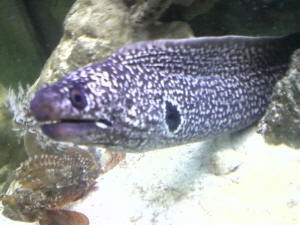
|
|
Eel Id
12/5/14
Hi this my baby moray I have no clue what he is he came
into the pet shop under the wrong species name it is just a baby only
about 20cm long with no top dorsal fin small eyes and small horns , it
has black-brown lined markings with the rest of him being a grey- white
colour . It also has a yellow area on it's tail . Thank
you for your time
<Mmm; yes: don't recognize right off... so I should send you to do as I
am:
Looking on Fishbase.org... under the family Muraenidae: Show species
images... scroll down... Is this a young Enchelycore ramosa? Gymnothorax
berndti? Perhaps another species... growth will show in time. Bob
Fenner>
|
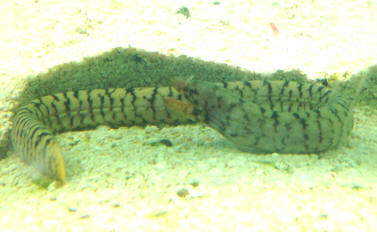 |
|
Moray eel identification problems – 09/9/13
Hello to whoever reads this at wet web media! I'm assuming it will be Marco,
and if so hope you are doing well my friend :)
<Yep. Still alive. :)>
Basically, I recently ordered a Banana moray eel from my LFS and had it
going into my 4ft 100 gallon aquarium. Since then there have been a few
issues on the identification on the eel I received with myself believing
it is a Dwarf golden moray eel (Gymnothorax melatremus) instead of
the true Banana moray from Brazil (Gymnothorax miliaris).
<Yes, both species can be traded as "Banana eel". Better use the scientific
names.>
Here's the problem, I ordered this eel a few weeks back and was promised a
14 inch Banana moray at £330, but there were issues with this one (had a
sore on its mouth) so the supplier ordered in another. I was never told the
size of the eel only that it was a banana moray, and it was to be delivered
by last Friday. When I obtained the eel the bag was not clear so couldn't
see into the bag well and even then it looked really small but I thought
that may just be the bag making an illusion. However when I returned home
and placed the eel in the acclimation bucket, I saw the bright blue eyes and
pinky orange characteristics of the Hawaiian dwarf moray eel. Here's a few
picture's and video of the eel I received. Acclimating
http://www.youtube.com/watch?v=S2N82uq5b6Y
In the tank (when he shakes his head can that be a sign of a parasite or
disease?)
http://www.youtube.com/watch?v=aaHn4dZQAsM
<Don't think this is a sign of a disease, but rather acclimation. Give it
some days and only if it continues research the cause.>
Also, when questioned about this the supplier said that they got the names
confused as the dwarf can also be called a Hawaiian banana moray but I have
never heard of this.
<As noted, both are sometimes called "Banana eel", the yellow morphs of the
Indo-pacific G. melatremus as well as their yellow G. miliaris relatives
from the Atlantic.>
Also seems strange as the first moray was supposed to be 14 inches+ but the
dwarf golden moray doesn't exceed 12 inches, so I am inclined to think they
have made this name up, but may be wrong. Also they said the true banana
moray is extremely rare (like they have never seen one before and will cost
much more than £330, is this also true)?
<It's rare, but not extremely rare and usually can be imported from Brazil.
I did this myself and had no problem getting this morph. They were sellable
around 200-250 Euro, larger ones up to 400 Euros, so £330 is a realistic
price.>
Thanks in advance! Love the work you guys do and the answers you give.
Really appreciate this as its being sorted out tomorrow so would love to
have this information ready to fight my cause if need be. :)
<G. miliaris and G. melatremus are most easily told apart by their eyes. G.
melatremus has a stripe through the eyes, which G. miliaris lacks. Your pics
are a little small, but I think I see the stripe in the videos. Since you
have Clownfishes, and a Toby in your tank it's even good you have G.
melatremus, which is much more harmless (an adult G. melatremus can eat a
small clown, though). I had a large, 2 feet yellow G. miliaris in the past
(and still have a smaller one) and clowns and maybe even the Toby would
definitely have been food for my specimen. It was harmless when young, but
that changes after about 6 years. Good luck with your G. melatremus, I found
this species much harder to obtain and better to keep due to the smaller
size. They hide more, though. Cheers, Marco.>
|
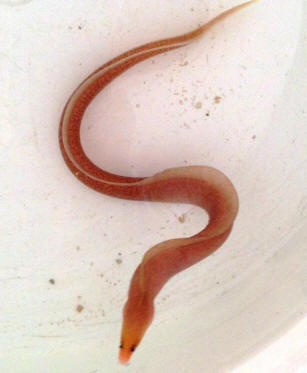
.jpg) |
Re: Moray eel identification problems
– 09/10/13
Thanks as always Marco! Great advice that I really appreciate :)
<Welcome.>
Just 2 more questions if you would be kind enough to answer.
Having a bit of trouble getting the dwarf moray to eat, any
good staple diet foods that you could recommend? Being trying a large
selection and he's not interested as of now.
<Yes, as with many or maybe even most eels it takes a while for them to
settle in and accept food. This can go on for weeks. Ghost shrimps can be
accepted in terms of live food, and for frozen food you can use pieces of
clams, mussels, octopus, calamari, various shrimps and fish filet.>
Also, how would the compatibility of both eels eventually in my tank sound?
Or would the Banana eel (miliaris) eventually consume the smaller dwarf
moray? (dwarf moray is around 10 inches at the moment)
<The latter can happen. I had a tiny G. miliaris with another species of
dwarf moray. Once the G. miliaris was significantly larger it attacked the
smaller eel and they had to be instantly separated. Co-housing Gymnothorax
eels of different size is generally not the best of ideas.>
Thanks again mate!
<Take care. Marco.> |
Norf'k Language 6/20/13
Dear WWM,
I noticed, while reading through your Page on Moray Eels (http://www.wetwebmedia.com/MorayIDF3.htm?h=)
, i found the following sentence:
<I see these features... this is almost assuredly a Gymnothorax
undulatus... a big puhi!
I am wondering if the word puhi is in the Norfolk Language, in which
case, it has been spelled incorrectly. It should in fact be Buhi (word
meaning a Moray Eel).
If it is not intended to be in the Norfolk Island Language then
disregard this message.
Cheers,
Silverso
<Mmm, don't know the connection, but this is also a Polynesian word... a
common appellation for moray et al. eels in Hawai'i'. Mmm, makes sense
re Norfolk Islands founders:
https://en.wikipedia.org/wiki/Norfolk_Island
Bob Fenner>
|
Requesting Hitchhiker Eel Identification
3/29/13
Greetings Crew,
<Hello Iishan.>
About 1 month ago I discovered an eel, that i never purchased, living inside
my 120 gallon reef aquarium. This aquarium has about 100 pounds of live rock
in it, and I must assume that the eel came with this rock.
<Happens.>
I bought all live rocks from my local fish store, and I have not bought any
of it from fellow aquarists. I have posted pictures of it on several forums,
but still have not made a positive ID.
<Will give it a try.>
The eel is about 7 inches long and roughly the diameter of a pencil,
although the dorsal fin makes it slightly taller. It has been in my tank for
about 5 years, which is when I bought the live rock and established the
aquarium. Since then I have not bought any new live rock, or anything large
enough for an eel to stow-away in. People on Canreef suggested that it could
be a Golden Dwarf Moray, but Golden Dwarf Morays have blue eyes with a
vertical black stripe over the pupil. Since mine does not, I am led to think
it is not a Golden Dwarf Moray.
<Certainly no G. melatremus.>
Any help you can offer would be greatly appreciated, and I think this is an
incredible and wonderful service you are offering the world. Thank you very
much.
<Let's see. It's a moray eel and no other type of eel. There are eight small
and brown morays known to science to far. Visible on your pics we have a
slightly darker rim around the eye and white pores on the jaw. This leaves
three species. I think we can rule out G. panamensis, which should be larger
after five years and has a slightly different head as well a dorsal fin
origin more in direction to the head of the eel. There remain G. atolli
(improbable, known only from Hawaii and Midway) and G. australicola (of
which also the shape seems to be a perfect fit to your eel). I'd say you got
yourself a Gymnothorax australicola (you are very lucky), a rather small
moray eel, although I cannot completely out rule G. atolli. They can only be
told apart by measuring their preanal length and counting their vertebrae.
Nothing you'd like to do on a living specimen.>
Regards, Iishan
<Cheers. Marco.>
|
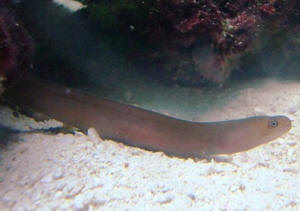
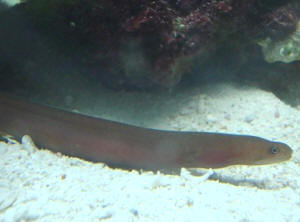 |
|
I saw this eel <these eels> on North Shore Oahu...do you
know what type it is? 11/2/12
I saw this eel on North Shore Oahu...do you know what type it is?
<The head looking out on the lower third of the picture belongs to a
Gymnothorax rueppellii. The other one where you can't see the head is
most likely a larger Uropterygius polyspilus and not Scuticaria tigrina
as some may think. Cheers, Marco.>
|
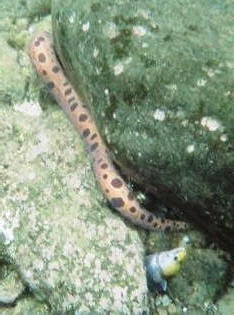 |
|
Re: I saw this eel on North Shore Oahu...do you know what
type it is?
11/4/12
Thanks for the prompt reply.
<Welcome.>
That makes sense...I had been thinking it was the head and body of the
same eel. Had not considered it was two different animals in proximity.
<Happens. Cheers, Marco.>
|
|
Eel ID 8/23/12
Hi guys!
<Hi Tim.>
Love the site! The LFS got this guy in recently. They say it is a
tesselata morph. It looks different than any I've scene in the past. A
Google search shows a "panda" morph,
<People...>
but these look different to me as well. They are purer white with less
round brown spots. This eel has a yellow/cream head, with less yellow
but still off white base color on the body. The eyes are also light in
color, which I cannot find on the web for this species panda morph or
not. I think it looks pretty sweet! So what do you think it is?
<What you have sent is a picture of Gymnothorax isingteena. It
has been debated in the past if this is really a separate species or
just a variation of G. favagineus, but currently it is considered valid.
Still, it is mixed a lot in books and on the net with G. favagineus and
the picture search will be of little use. G. isingteena gets around 6
feet long and behaves just like other Gymnothorax species of this size.>
And is something like this worth a few hundred bucks, or are they trying
to make some fast money?
<You as the customer decide if this is worth the suggested price. It
certainly is less common in trade than G. favagineus, but nor really
rare in nature.>
Thanks, Tim
>Welcome. Cheers, Marco.>
|
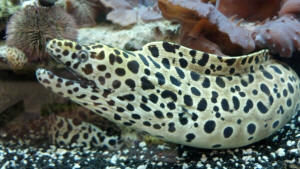 |
Moray Question, ID 2/3/12
Hello,
Is Marco still with WWM? I have a moray question I'd like to run by
him.
<Oh yes... he's here... well, actually in Germany; but checks in
daily.
BobF>
Best,
Pat Corcoran
Re: Moray Question 2/3/12
Splendid. It's been a while since I was in contact with him but
perhaps he could lend his expert eye to the attached photos... I have
my suspicions (hopes) but wanted to see what he thinks without the
power of suggestion interfering.
<Hi Pat, pretty sure this is Gymnothorax shaoi.
Congrats on the find! A few have occurred in the aquarium trade in the
last years.>
Also, these pictures and the specimen within are not mine (yet)
so please do not publish them on WWM. If it's what I hope
it is I will send you crystal clear pictures to feature there.
<Would be good. This is worthless without pictures for other
readers.
Cheers, Marco.>
Re: Moray Question 2/3/12
Since I sent the email below I did further research and I believe I
came up with a final conclusion. I'll be blown away if Marco is
able to nail this one without scrounging Fishbase for an hour and a
half like I did.
<Mmm, I do wish his books were available in English (all just
German). He is the real thing. BobF>
Re: Moray Question 2/4/12
Say it ain't so Marco! I guess I'll just have to learn
German... Thanks!
<I think Bob is exaggerating, but for what it is worth,
everything's in German, except a few articles (e.g. some in Coral
magazine). However, there is not much information on Enchelycore
species included anyway, since they are generally not that common in
trade. I would have loved to do a book on all moray eel species, but it
would be quite a lot of material, consequently very expensive (just
think about buying all the picture rights) and has little to no market.
Cheers, Marco.>
Re: Moray Question 2/4/12
Wonderful to hear from you Marco - this came in as a suspected
E. kamara.
<Sorry, I'm quite sure, it's not. The spots on E. kamara are
much more chaotic and not clearly arranged in lines as on your future
eel, also the head is totally off. E. kamara also has fins with more
spots, and much more and smaller spots.>
I think hope blinded me, but after an hour and change of reading around
on Fishbase, I found a picture of this beauty, along with an academic
article on the subject.
<Beware of the Fishbase photograph of E. kamara, that's G.
shaoi, too, in my opinion (specimen also apparently comes from the G.
shaoi area). The E. kamara drawing on Fishbase shows much better how
this eel looks like.>
I expect to pick him/her (and based on the content of the article, I
will be able to tell based on dentition when the animal is full grown)
in the next week or two, a which point I'll send you some good
quality pictures for WWM readers.
<Superb! Eels of this species have been imported in the past, not as
G. shaoi of course, since this species wasn't recognized back then.
They came as G. fimbriatus in general and the adults do look somewhat
similar. G. shaoi lacks the yellow head of course. Here's one of
these "G. fimbriatus" G. shaoi
http://www.riffaquaristikforum.de/forum/index.php?page=Attachment&attachment
ID=35247&h=44d77b3f91bd329bce8093402de6d002c6b04a0b >
In the mean time, below is a link to the article which contains
interesting information and a few pictures.
http://jmst.ntou.edu.tw/marine/15-2/76-81.pdf
<Thanks, that's the first description.>
Best, Pat Corcoran
<Cheers, Marco.>
Re: Moray Question 2/4/12
No need to be sorry - I'm quite happy with your diagnosis. This is
going to be an excellent addition to my collection.
<I bet so.>
If you do wind up writing a book containing more Moray species I would
be happy to share pictures royalty free as gratitude for all your
assistance.
<Thanks, that's great and every bit helps. Also, if you ever
decide to share your knowledge about some of your rare species in an
article, feel free to send it to WWM.>
I'm still on the hunt for ramose and schismatorynchus, and kamara
obviously. The anatina are doing marvelously, though I still think
lichenosa may be my all time favorite.
<I see. My favourite Enchelycore is carychoa... haven't seen one
over here a long time.>
Best, Pat Corcoran
<Cheers. Marco.>
|
Moray Eel Identification
11/16/11
I occasionally get a species of moray eel from Sri Lanka that I
have yet been able to identify. I have attached a picture. If you
know what it is I would certainly appreciate your answer.
Thank you, Aaron Dragseth - Aqua Life Aquarium
<Mmm, I think this may be Gymnothorax fimbriatus, but am going
to put your msg. in MarcoL's hands for a look/see as well.
Bob Fenner>
Re: Moray Eel Identification 11/16/11
Thank you for getting back to me so quickly, I'm really
interested in seeing what Marco and Bob have to say. I'm
pretty sure that it's not a fimbriatus though. Gymnothorax
fimbriatus has a tan body with black
blotches and this species has a darker body with white spots. I
do agree that the head and body style do resemble a fimbriatus
but unless it's a very different color morph, I think
it's a different species. Regards,
Aaron Dragseth
<+1. Marco.>
Moray Eel Identification
11/16/11
I occasionally get a species of moray eel from Sri Lanka that I
have yet been able to identify. I have attached a picture. If you
know what it is I would certainly appreciate your answer.
Thank you, Aaron Dragseth - Aqua Life Aquarium
<Hi Aaron, we've had this species here on WWM in the
past... see http://www.wetwebmedia.com/MorayIDF5.htm
(scroll 2/3 down). I ID'd them as G. johnsoni last
year and it has occurred in trade since (I only get bloody, sorry
I mean blurry pics, no specimen), but with your picture I have to
correct myself. Both likely are Enchelycore nycturanus.
Your pic shows how slender the jaw really is. This species was
described 2002:
http://www.mapress.com/zootaxa/2002f/zt00104.pdf
. If you want to be sure look at the teeth, they are different in
G. johnsoni and E. nycturanus as noted in the linked paper.
Maximum size unknown so far. Cheers, Marco.>
Re: re: Moray Eel Identification
11/16/11
Thanks Marco! That's a big help. I'm going to take a
closer look at the eels mouth tomorrow to see if I can get a
definite ID. I will let you know what I come up with.
<Okay. Looking forward to it. Marco.>
|
|
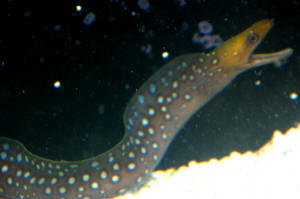 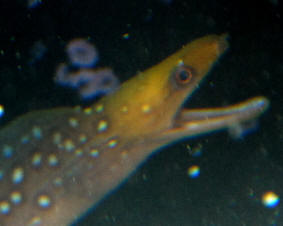
|
|
Re: re: Moray Eel Identification 11/21/11
So far your I.D. of E. nycturanus seems to be the best answer
that I have received. I wasn't able to confirm the teeth
because the eel is too small and too slippery and I didn't
want to hurt him trying to get into his mouth. I looked at some
pictures of G. johnsoni and the spots seem to be more abundant
and more irregular than the spots on the eel that I have. The E.
nycturanus definitely looks closer but I did notice more spots on
its head than on the specimen that I have. I also took note that
E. nycturanus is found in South Africa and possibly endemic to
Ailiwal Shoal. This area contains an extensive cool water,
habitat that has no equivalent elsewhere in the Western Indian
Ocean. The specimen that I have was collected by my supplier in
Sri Lanka. I know that this rarely seen eel is far too new and
probably not enough is known about it to actually have an
accurate distribution range but what are your thoughts?
<I agree with you. With regard to coloration I'd note that
the specimens illustrated in the first description are dead and
some characteristics of color can be lost during preservation. I
suppose the yellow of the head is more vibrant on living
specimens for example. Yes, the species is new and so far only
known from a subtropical location. No adult specimen has been
documented and the range is not known for sure. There still
remains the possibility that the specimens from Sri Lanka are a
new species, maybe closely related to the one from SA. It's
also possible that there are different populations (still
belonging to one species) like there are for E. pardalis, which
occurs in subtropical and tropical waters. In unclear cases open
nomenclature can be used such as Enchelycore cf. nycturanus, the
"cf." comes from Latin and means "Compare!".
It's used when you think your specimen could be this species,
but shows some differences that need clarification (telling
others to compare it to more material). I have only seen pictures
of both populations so far, which is too little for a better
statement.>
Thank you, Aqua Life Aquarium
<Welcome. Marco.>
Note: for a more professional opinion you can also ask D.G.
Smith. I'd also be interested in the result if you try this.
Marco.
|
|
Muraena melanotis ??
8/10/11
Hi.
<Hello.>
I have this little moray, and I really want to ID it. I think it
could be a Muraena melanotis (African dragon moray)?
<Yes, this is definitely right. Nice find.>
And how fast will it grow?
<Typically morays of this size are grown within approx. 4-6
years in nature. There are few examinations of ear bones, which
can tell the age of a fish.>
My tank is something around 180gal. I think my tank could house
an adult?
<I think this can work as the minimum size (avoid other
fishes), although a bigger tank would be better.>
Best regards
Alexander
<Cheers, Marco.>
|
|
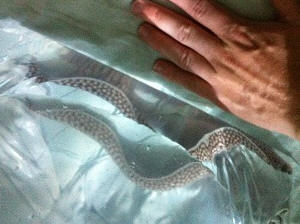 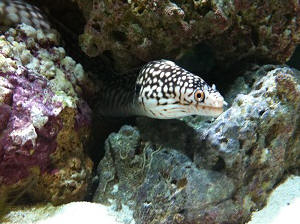
|
|
Moray Eel ID 7/4.5/11
Aloha,
<Howdy>
I'm attaching two photos that I hope show some good
distinguishing characteristics of an eel I recently collected
from the reefs west of Oahu. Looking through your Moray articles,
fish base, and my reef fish picture books, the best almost
matches I've found are: G. richardsoni, G. kidako, and G.
eurostus the eel is currently about 12" - 15" long and
about 1.5" in height.
<Mmm, maybe the last... or G. buroensis, the Lattice/work
Moray>
The markings look similar to a yellow margin moray, but the eel
lacks the margin on the tail. Distinctive in the photos (at least
to my untrained eye) is the lighter/whiter underside, and the
distinctive bands, that lean me towards the G. eurostus. It's
mouth is darker and similar in color to it's external
markings, and is equipped with many smaller (though still sharp
looking) teeth that resemble molars (again to the untrained
eye).
I've been looking at moray information for about 8 straight
hours so I probably breezed past an exact match without even
catching it!
<Heeeee!>
What do you think it is?
<I think I'll put in our resident Muraenid expert,
Marco's in-folder and let him respond. Cheers>
Thanks in advance, and of course for all the work you've done
creating and maintaining what I believe is an outstanding source
for allowing the marine aquarium hobby to be entertaining,
enlightening, and sustainable.
Mahalo,
John
<A hu'i hou! Bob Fenner>
|
|
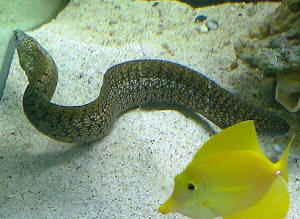 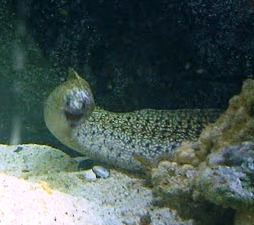
|
|
Moray Eel ID 7/5/11
Aloha,
<Good Morning.>
I'm attaching two photos that I hope show some good
distinguishing characteristics of an eel I recently collected
from the reefs west of Oahu.
Looking through your Moray articles, fish base, and my reef fish
picture books, the best almost matches I've found are: G.
richardsoni, G. kidako, and G. eurostus
<Bingo!>
the eel is currently about 12" - 15" long and about
1.5" in height.
The markings look similar to a yellow margin moray,
<Don't think so.>
but the eel lacks the margin on the tail. Distinctive in the
photos (at least to my untrained eye) is the lighter/whiter
underside, and the distinctive bands, that lean me towards the G.
eurostus.
<You got it.>
It's mouth is darker and similar in color to it's
external markings, and is equipped with many smaller (though
still sharp looking) teeth that resemble molars (again to the
untrained eye).
<Don't put this to the test on your fingers. These things
are very sharp I bet.>
I've been looking at moray information for about 8 straight
hours so I probably breezed past an exact match without even
catching it!
What do you think it is?
<G. eurostus. Head shape and in this case even the markings
are very typical.>
Thanks in advance, and of course for all the work you've done
creating and maintaining what I believe is an outstanding source
for allowing the marine aquarium hobby to be entertaining,
enlightening, and sustainable.
<Thanks for your kind words.>
Mahalo,
John
<Cheers, Marco.>
|
|
Moray Eel ID 6/21/11
Hello Wet Web Media Crew,
<Hello Ehren.>
I recently got an assorted moray eel from my LFS and was
wondering if you could help me identify it. I have looked all
over the Internet with no luck. It's coloration is blotchy
brown and white and is about ten inches in length. I have
attached some pictures that will hopefully help.
<It's definitely Gymnothorax richardsoni (sometimes
written richardsonii), a small (barely reaching one foot) eel
similar in care to the Golden dwarf moray (G. melatremus),
You'll find some posts about this species on WWM.>
Thanks for your time!!
<Welcome.>
-Ehren
<Cheers, Marco.>
|
|
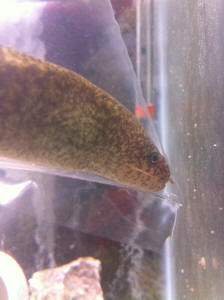
|
|
Moray Eel ID 5/28/11
Hello,
<Hi Chuck.>
I received a juvenile eel, and thought it was a golden dwarf. I
don't really know if it is, since the eyes do not have the
blue tint. They are white with a black pupil. Attached is a
picture of the head. It's about
8" long right now. It is the correct coloration for a golden
dwarf, except it does not have the black dot by the gill opening.
The throat area is a reddish color when it puffs up. I will
attempt to get a close picture. It is from Hawaii. Any help would
be appreciated.
Thanks, Chuck
<I fear there is too little detail visible for a proper ID.
Try a clear picture at a closer distance. My best guess so far
is: Gymnothorax konodontos, see here for a proper online
picture:
http://www.fishbase.org/Photos/PicturesSummary.php?ID=58597&what=species
.
Cheers, Marco.>
<Gymnothorax kontodontos is the proper spelling in contrast to
the last email, of course.>
|
|
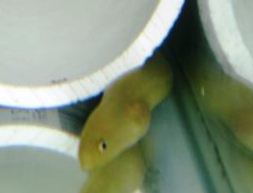
|
Re: Moray Eel ID 5/28/11
Thank you for the quick response. I have attached a couple more
pictures.
<Thanks Chuck and sorry, I still cannot see the necessary
characters for a proper ID such as where the dorsal fin starts and
especially how exactly the sensory pores on the head are arranged
and how the narines look like.
There are about 5 small moray candidates from Hawaiian waters in my
head right now. I cannot see a dorsal fin on the first half of the
body on your pictures and it appears only the tail is slightly
mottled. If you can confirm these two characters, Uropterygius
fuscoguttatus would likely be the ID. Marco.>
-Chuck
re: Moray Eel ID 5/28/11
Thank you. After looking at the eel, and looking at pictures
online, it does look like the snake eel. It does not have the
raised fin in the back like most morays. Thank you for pointing me
in the correct direction!
-Chuck
<Welcome. Marco.> |
|
ID and feeding question. 5/26/11
I think it is either an hourglass moray or a reticulate moray but
im <I'm> not sure. I would like a positive ID.
<Muraena clepsydra.>
I have this moray who is 16" long and as thick as a golf
ball (would this be an adult?)
<With 16 inches? Can still grow a lot... 3 feet and a few
inches (1m -1,1m) is a realistic adult size.>
in a 300g tank. It is a well established tank for years. He
refuses to eat anything at all even though it has been 2 weeks
now.
<A moray not eating for two weeks after being moved is nothing
unusual.
Please see http://www.wetwebmedia.com/morays.htm
and the linked FAQs.>
He wont eat live or frozen. When I feed the other fish in the
tank he goes crazy trying to find food but never tries to catch
his tank mates or takes from a feeding stick. Im <I'm>
not sure what else to try.
<More patience and keep on trying. Can take more than a month
(sometimes several months) with morays of this size. As long as
no symptoms of a disease occur you'll likely be fine. Try
offering various marine fish fillets, larger shrimps, octopus or
squid (especially the last two are quite popular among morays of
the genus Muraena. Also check if the water parameters are in line
(nitrates < 30; pH around 8.2). Cheers, Marco.
|
|

|
|
|

